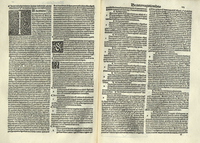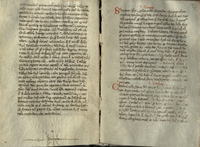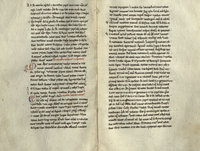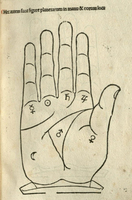Browse Items (49 total)
- Tags: Ballard Collection
Sort by:
Tetrabiblos (Quadripartite)
The Tetrabiblos examines the influence of the stars on human affairs.
De Urinis
This manuscript version of Isaac Israeli’s treatise on urine is part of a larger compilation of texts which was probably used by a German medical student (the binding is typical of German craftsmanship and materials). The lack of embellishment…
Kitab al-Maliki
This work is also attributed to Haly Abbas. Also included in this volume are Constantine the African’s De Stomacho (On Diseases of the Stomach) and Marbode’s De Lapidibus (On Stones). This volume is bound in a vellum leaf of manuscript,…
A Tutti Voi Mercanti
This document bestows legal, religious, and commercial privileges on foreign merchants and the Jewish community in the cities of Pisa and Livorno. Section 18, on the right hand page, grants Jews the right to practice medicine, and section 20 grants…
Viaticum
The Viaticumis a systematic and detailed medical handbook originally written in Arabic and translated at least 3 times into Hebrew. Its popularity in medieval Europe is well-documented. The Latin translation on view here is almost certainly the work…
Lilium Medicinae; De Phlebotomia
Bernard de Gordon taught in the medical faculty at Montpellier, which was a refuge for Jewish students from Spain. The Lilium Medicinae, written in 1303 and first printed in Naples in 1480, must have been well-known and well-used, as there were 7…
Astronomica
This is a collection of 38 treatises on astronomy, astrology, and mathematics, including one of León Hebreo, (De coniunctione Saturni et Iovis anni Christi 1345 (On the conjunction of Saturn and Jupiter in the year of our Lord 1345).
Relatio de Simone Puero Tridentino (Bartholomaeus Guldinbeck, 1475)
The story of Simon of Trent is among the most egregious examples of the “blood libel” against Jews. This accusation usually involves the sacrificial killing of children whose blood is then used in various rituals, among them the making of…
Relatio de Simone puero Tridentino (Albrecht Kunne, 1476)
The story of Simon of Trent is among the most egregious examples of the “blood libel” against Jews. This accusation usually involves the sacrificial killing of children whose blood is then used in various rituals, among them the making of…
Relatio de Simone Puero Tridentino (Gabriele di Pietro, 1475)
The story of Simon of Trent is among the most egregious examples of the “blood libel” against Jews. This accusation usually involves the sacrificial killing of children whose blood is then used in various rituals, among them the making of…
Liber Aggregatus in Medicinis Simplicibus
This is the first medical book – an Arabic work on medicine, pharmacology, and therapeutics – translated by a Jew (Abraham of Tortosa, fl. 13th century). “Simples” are the foundations (plant, animal, or mineral) upon which…
Mishnah (compendium of Jewish Oral Law) with commentary of Maimonides
Maimonides composed his Judeo-Arabic commentary on the Mishnah (known in Arabic as Kitab al-Siraj; in Hebrew, Sefer ha Ma’or) between 1145 and 1168. The Mishnah, compiled in the 2nd century CE by Judah ha-Nasi, is divided into six main sections…
De Regimine Sanitatis ad Soldanum Babyloniae
This is an early work on hygiene and longevity addressed to the Egyptian Sultan Saladin; Maimonides served as physician to the vizier of Saladin. Maimonides offers advice on such subjects as diet in health and disease, common illnesses, and…
Aphorismi Secundum Doctrinam Galeni
This volume, the first printed edition of Maimonides’ interpretation of Hippocratic and Galenic doctrine, also includes the Aphorismi of St. John of Damascus, Razi’s De Secretis in Medicina, and Hippocrates’ Prognostica. Maimonides,…
Opera
This edition of Josephus' entire oeuvre includes the Contra Apionem, an apologetic work on behalf of Judaism. This copy, unrubricated save for the occasional crudely drawn initial, stands in stark contrast to the copy of De Antiquitate Judaica.
De Antiquitate Judaica; De Bello Judaico
Josephus, born in Jerusalem, had a multifaceted career as priest, soldier, and historian. His retelling of Jewish history and partially first-hand account of the rebellion against the Romans (66-70 CE), originally written in Aramaic (now lost) and…
Oratio in Die Circumcisionis Anno 1484 Habita
This sermon on Christ’s circumcision, given before Pope Sixtus IV in 1484, explores the symbolic aspects of the ritual and compares it to Christ’s eventual suffering on the cross. Carvajal claims that the process of circumcision and its…
Anulus astronomicus
Bonet de Lates was a Provençal physician and astrologer who settled in Rome, where, in addition to acting as physician to Popes Alexander VI and Leo X, he served the Jewish community as a rabbi. He is best known for his invention of the…
Perush 'al ha-Torah
This volume is a commentary on the Pentateuch (the first five books of the Hebrew Bible). Only 6 books are known to have been printed by Conat, who introduced Hebrew printing in Mantua in 1474. Conat's wife Estellina was the first woman to become…
Opera of Aristotle
Volume one of the first printed edition of Aristotle’s works in Greek.
Somnia Danielis
The Somnia Danielis [“Daniel’s Dreams”] is a work on the interpretation of dreams; it originated in the eighth century.
Cantica de medicina
This lesser-known medical work of Avicenna is bound in a manuscript musical sheet with an unusual skull-and-crossbones illuminated initial.
Herbolarium de virtutibus herbarum
The Herbolarium describes the medicinal uses of common herbs and plants with woodcut illustrations of each. The work was once attributed to the medieval physician Arnaldus de Villanova (d. 1311) because of this imaginative frontispiece depicting a…
Pestblatt
This broadside sheet was printed during an epidemic of plague in the German city of Augsburg in the early 1470s. The woodcut depicts Saints Sebastian and Roch (accompanied by an angel), comforting those struck down by the plague. Prayers to the two…
Lines of the hand and their associated zodiac symbols
Chiromancy or palmistry is the study of the lines and shapes of the human hand to determine an individual's characteristics and analyze past, present, and future events. Books on the subject were among the most popular incunables produced. This brief…
Ein hubscher Tractat von dem Ursprung des Bösen Franzos
This small pamphlet on syphilis [A Fine Treatise on the Origin of the French Evil] was enormously popular, appearing in four different editions in Latin and German in the last years of the fifteenth century. The pamphlet was printed during the course…
Das Buch der Cirurgia
Brunschwig's Book of Surgery was intended to be a manual of general practice for the independent surgeon and is the first printed German text on this subject. The Cirurgia contains information on the treatment of wounds, dislocations, fractures, and…
Das Buch der Croniken und Geschichten
The first German edition of Hartmann Schedel's famous Nuremberg Chronicle traces the history of the world through six ages, from the Creation to 1493, concluding with the Apocalypse. Michael Wolgemut and Wilhelm Pleydenwurff designed maps, city…
Hortus sanitatis
The Hortus sanitatis [Garden of Health] was a popular compendium of plant and herb lore during the Middle Ages. This is the first Latin edition, and twenty others were printed in Latin before 1547 attesting to its popularity. In addition to botanical…
Fasciculus medicinae
Although notable as one of the first incunables acquired by the Boston Medical Library, this first edition of the Fasciculus medicinae is also a cornerstone in the history of medicine, as it contains the first detailed anatomical illustrations ever…
De revelatione facta ab angelo Beato Methodio in carcere dete[n]to
This book of prophecies attributed to the fourth-century martyr, Methodius, was probably composed by a fifteenth century monk, Wolfgang Aytinger, to arouse animosity between Christians and Muslims. Although not specifically medical, the De…
Almanach ad annum 1494
Almanacs were used to record the most propitious days and times for purging, bloodletting, and pharmaceutical manufacture according to astrological and astronomical events. This specimen for the city of Erfurt in 1494 includes woodcuts depicting…
Engraving of Skeleton
This unusual copper engraving is one of the earliest printed representations of the human skeleton, predating Andreas Vesalius' De humani corporis fabricaby nearly half a century. Only two other specimens are known.
The engraving appears to be only…
Canon medicinae
The Canon medicinae, a compendium of medical knowledge and a guide to clinical teaching, was derived from Galenic and Hippocratic writings and infused by Avicenna with Arabic medical lore. The Canon includes detailed disquisitions on pathology,…
Regimen sanitatis
Probably the most popular medical work of the fifteenth century, the Latin Regimen sanitatis [Rule of Health] was translated into almost every European language following its first appearance in print in 1480. Nearly forty different editions were…
De medicina
One of the first medical books ever printed, the De medicina is a compilation of knowledge of diet, pharmacy, and surgery from the time of Imperial Rome, circa 30 A.D. In the Renaissance, Celsus' elegant style earned him the title of Cicero…
De sermonum proprietate, sive, Opus de universo
This encyclopedia of a ninth-century archbishop is the oldest incunable in the Boston Medical Library collection. The De sermonum proprietate contains chapters on subjects as diverse as the earth, animals, precious stones and metals, heretics,…
Malleus maleficarum
This is a first edition of the Malleus maleficarum [The Witches' Hammer], the foremost legal and theological handbook on witchcraft and demonology. It describes the operations of witches, remedies against spells, and the judicial proceedings of…
De bello Peloponnesiaco
Thucydides was a fifth-century Greek and eyewitness to the long struggle (431-404 B.C.) for dominance between the warring city-states of Athens and Sparta. De bello Peloponnesiaco, or The History of the Peloponnesian War, his contemporary account of…
Iusiurandum
At the end of Nicolaus Perottus' De generibus metrorum appears one of the most famous documents in the history of medicine, ethics, and education: the first printing of the Iusiurandum, the Hippocratic Oath. While certainly not composed by…
De Febribus
Isaac Israeli was born in Egypt and studied widely in natural history, mathematics, astronomy, and medicine. He settled in Kairwan, Tunisia, where he served as court physician to the caliph and wrote several esteemed medical and philosphical works in…
A leaf from the Canon Medicinae of Avicenna
This manuscript copy of Avicenna's Canon, written by Mordechai bar Elia in a rabbinical hand, was formerly in the library of Prince Dietrichstein of Nikolsburg.

















































